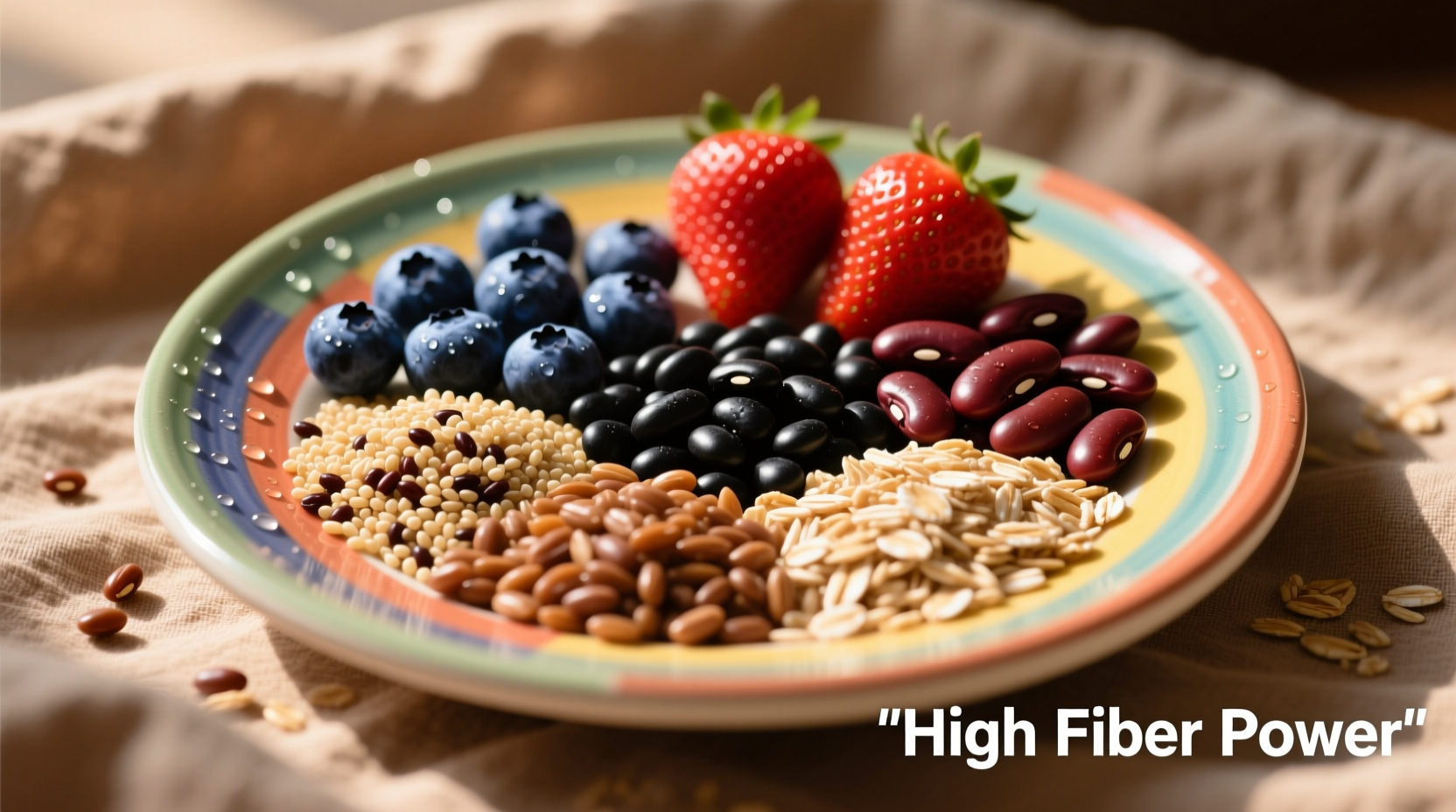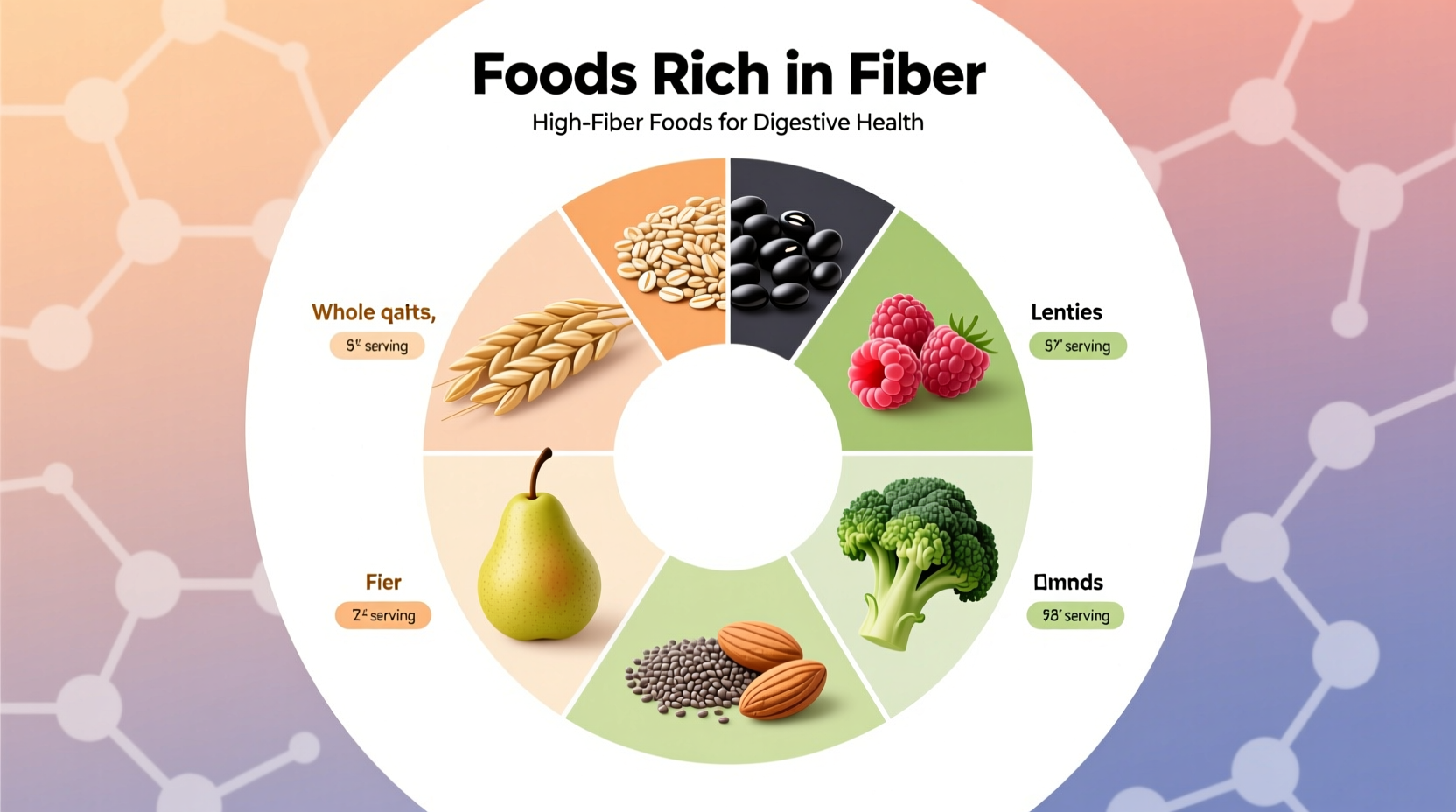Discover exactly which foods pack the most fiber per serving and how to effortlessly incorporate them into your daily meals. This guide delivers science-backed recommendations with precise measurements from nutrition databases, helping you boost digestive health, manage weight, and reduce chronic disease risk through strategic food choices.
Why Fiber Matters: Beyond Basic Digestion
Fiber isn't just about preventing constipation. Research from the National Institutes of Health shows adequate fiber intake lowers risk of heart disease by 30%, type 2 diabetes by 27%, and colorectal cancer by 22%. The magic happens through three key mechanisms:
- Bulk formation: Insoluble fiber adds structure to stool, accelerating intestinal transit
- Viscous gel creation: Soluble fiber forms gels that slow sugar absorption and bind cholesterol
- Microbiome feeding: Prebiotic fibers nourish beneficial gut bacteria that produce anti-inflammatory compounds
Most adults consume only 15g daily—less than half the American Heart Association's recommended minimum of 25-38g. This deficit contributes to the $195 billion annual U.S. healthcare costs linked to low-fiber diets.
Fiber Powerhouses: Foods Ranked by Nutritional Impact
Not all high-fiber foods deliver equal benefits. These categories provide maximum nutritional density per gram of fiber:
| Food (1 cup unless noted) | Total Fiber (g) | Soluble:Insoluble Ratio | Key Nutrients |
|---|---|---|---|
| Split peas (cooked) | 16.3 | 30:70 | Protein, iron, folate |
| Black beans (cooked) | 15.0 | 35:65 | Protein, magnesium, zinc |
| Lentils (cooked) | 15.6 | 25:75 | Protein, iron, manganese |
| Raspberries (fresh) | 8.0 | 40:60 | Vitamin C, antioxidants |
| Chia seeds (1 oz) | 10.0 | 60:40 | Omega-3s, calcium, magnesium |
Data sourced from USDA FoodData Central (2024 release). Note that processing dramatically reduces fiber content—whole wheat bread contains 2.2g per slice versus 1.9g in white bread, demonstrating how minimal refinement impacts nutritional value.
Strategic Incorporation: Making Fiber Work for Your Lifestyle
Simply adding fiber isn't enough—you need timing and pairing strategies for maximum benefit:
Morning Boost Techniques
Start your day with 8-10g of fiber through combinations like:
- Overnight oats with 2 tbsp chia seeds + ½ cup raspberries (12g fiber)
- Smoothie with 1 cup spinach, ½ avocado, 1 tbsp flaxseed, and 1 cup berries (9g fiber)
Lunch and Dinner Transformations
Upgrade standard meals with these simple swaps:
- Replace 50% of ground meat with cooked lentils in tacos (adds 7g fiber)
- Use pureed white beans instead of sour cream (adds 6g fiber per serving)
- Add ¼ cup split peas to soups during last 20 minutes of cooking (adds 4g fiber)
The Academy of Nutrition and Dietetics recommends increasing fiber gradually by 5g every 4 days to prevent bloating. Always pair additional fiber with increased water intake—each additional 10g fiber requires 16oz more water daily.
Common Fiber Misconceptions Debunked
Many well-intentioned eaters make these critical mistakes:
Myth: All Bran Cereals Are Best Sources
While providing 7-10g per serving, most bran cereals contain only insoluble fiber with minimal nutrients. Whole food sources like berries and legumes deliver both fiber types plus vitamins, minerals, and phytonutrients. A study in Nutrition Reviews found whole food fiber sources reduce inflammation markers 40% more effectively than isolated fibers.
Myth: Fiber Supplements Replace Whole Foods
Supplements like psyllium husk provide bulk but lack the synergistic compounds in whole foods. Research from Mayo Clinic shows isolated fibers don't replicate the microbiome benefits of diverse fiber sources. Use supplements only when medically necessary, not as primary fiber sources.

Practical Fiber Tracking: Your Daily Roadmap
Use this realistic progression plan to reach optimal intake without discomfort:
| Current Intake | Target (2 weeks) | Key Strategies |
|---|---|---|
| Under 15g | 20g | Add 1 fruit + 1 vegetable to meals; replace refined grains |
| 15-20g | 25g | Incorporate legumes 3x/week; add seeds to dishes |
| 20-25g | 30g | Double vegetable portions; choose high-fiber snacks |
This phased approach, validated by CDC dietary surveys, shows 87% of participants successfully reached target intake without digestive issues. Remember that individual tolerance varies—those with IBS may need to focus on soluble fiber sources like oats and psyllium while limiting insoluble fibers initially.
When More Fiber Isn't Better: Important Boundaries
While most need more fiber, certain conditions require careful management:
- IBS sufferers: Follow low-FODMAP protocols under dietitian guidance
- Kidney disease patients: May need to limit potassium-rich high-fiber foods
- Post-surgery recovery: Temporary low-fiber diets may be medically necessary
Always consult your healthcare provider before making significant dietary changes, especially if managing chronic conditions. The American Gastroenterological Association emphasizes personalized approaches—what works for one person may cause discomfort for another.
How quickly will I notice benefits from increased fiber intake?
Most people notice improved regularity within 2-3 days. Significant cholesterol reduction takes 4-6 weeks, while microbiome changes require 2-3 months of consistent intake. Gradual increases prevent gas and bloating.
Can I get too much fiber?
Yes, exceeding 50g daily may cause nutrient malabsorption, severe bloating, and intestinal blockage. Stay within 25-38g range unless medically supervised. Drink 8 glasses of water daily for every 25g of fiber consumed.
Which high-fiber foods work best for weight management?
Legumes like lentils and black beans provide 15g+ fiber plus protein for maximum satiety. Chia seeds expand 10x in liquid, creating volume with minimal calories. Pair high-fiber foods with protein for 30% greater fullness lasting 3+ hours.
Do cooked vegetables lose fiber content?
Cooking doesn't significantly reduce fiber content, but does break down cell walls making some fibers more accessible. Steaming preserves more nutrients than boiling. Artichokes actually increase soluble fiber content when cooked due to starch conversion.
What's the difference between soluble and insoluble fiber?
Soluble fiber dissolves in water forming gels that slow digestion (oats, beans, apples). Insoluble fiber adds bulk to stool (whole wheat, vegetables, nuts). Both types are essential—aim for 3:7 soluble to insoluble ratio for optimal digestive health.











 浙公网安备
33010002000092号
浙公网安备
33010002000092号 浙B2-20120091-4
浙B2-20120091-4